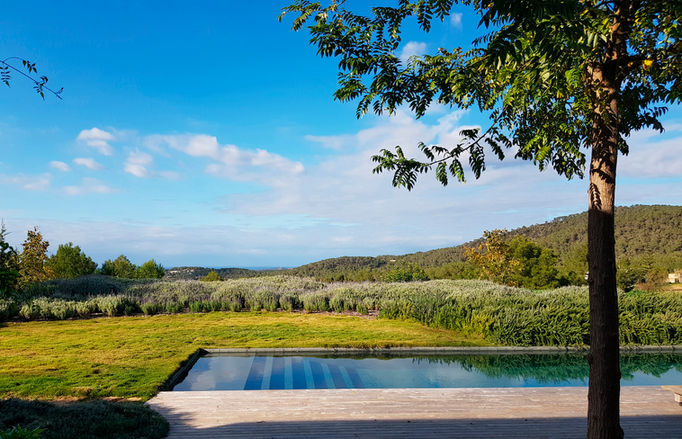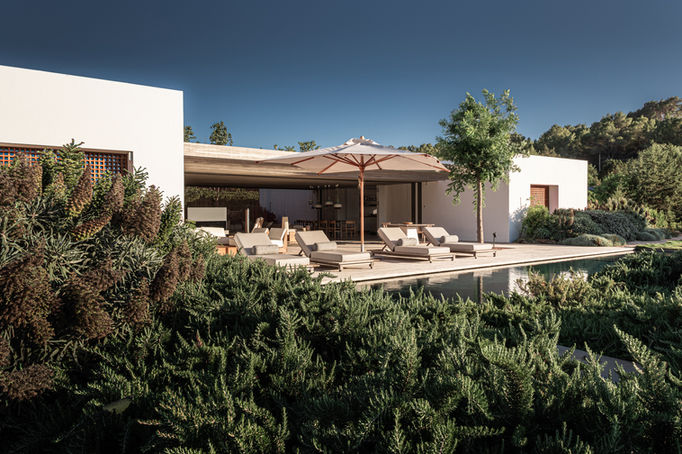GARDEN IN IBIZA
Ibiza, Spain
by Isabel Duprat
The first visit to Ibiza, at the beginning of the summer of 2018, was filled with expectation. The turquoise and emerald colored sea below, the salt pans approaching, and the arrival at this mythical island seemed to correspond to my imagination. When we left the airport, however, involved in intricate traffic, roundabouts, expressways and viaducts in any direction, with many big and small buildings, made me feel a discomfort, the kind you have when you arrive in a place that is not the expected. The arrival by sea may be more pleasant, more friendly. The fact that we were on business and not on a trip helped to digest the mixed feelings as we followed the signs in Catalan and Spanish, once the GPS could not assist us.
As you move away from Eivissa, which contains the beautiful old area of the walled city, towards the southwest, where the property we were going to visit is located, the road begins to wind through a rocky landscape, through terraced lands, terraces with walls of stone, many conifers and views of the blue colored Mediterranean. Ibiza is to be discovered. Everyone has to find their group and their beach, their silence or their party, their hidden corner among the infinite bays and recesses of the steep relief.
On each trip we got to know each other and appreciate this island located between the peninsular “Lenvantine” coast and North Africa, and which together with Mallorca, Minorca, Formentera and other islets, form the archipelago of the Balearic Islands. Its strategic position has attracted countless visitors over the centuries, bringing and leaving its marks and reminiscences among the Phoenicians, Carthaginians, Romans, Byzantines and Arabs.
Ibiza and Formentera have an important endemic fauna and flora and are known as Pitiusas Islands, due to the amount of pine trees covering their relief. Between the two islands, a vast padera, a meadow of “Possidonia oceanica”, an aquatic plant that gives the beautiful color of these waters, has been officially declared a World Heritage Site.
Ibiza is south of the Balearic Islands. The climate is hot, dry, especially in summer. The temperature varies between 8 and 29°C with an average temperature of 18°C throughout the year. The rainiest month is November. But it rains very little throughout the year, just around 400 mm.
The 3,3-hectare site on which we would carry out our project is in San José, the largest municipality in Ibiza, with important areas of natural reserves.
A few almond and olive trees, many conifers like the Sabines and Juniperus oxycedrus, and a beautiful Ceratonia, spread across the land.
Marcio Kogan's project of two houses, “upper and lower house”, its annexes and swimming pools, in addition to an semi-olympic swimming pool, were already well under construction. The houses of two different clients should have their privacy guaranteed, so circulation and vegetation ought to promote this requirement.
The property, like so many we saw on the way, had in the past been terraced with stone walls for farming.
With intense mobilization of the land due to the foundations and other installations of the work, practically all the better-quality land that covered the terraces of the old plantations and, therefore, accumulated a thin layer of plant matter over time besides being already covered with native vegetation, had been largely removed leaving an inert soil to be recovered. In other words, a big problem.
I come across this situation a lot, where the land undergoes a lot of change during the civil work. The greater the terrain, the more the work advances, the more it spreads and the more it destroys. The areas where the interventions will not take place should always be preserved with the organization of the construction site and the circulation of the construction itself, because this movement, in addition to the soil compaction, invades the entire terrain and surroundings, contaminating it with dirt, rubble and leftover materials.
The cost and difficulty of subsequent recovery is enormous, and it is necessary, as in this case, to irrigate areas where there used to be native vegetation, so that with fertilization and sowing they can recover, but it will take a long time.
Although the buildings were already in place, the entire circulation was not defined, whether pedestrian or automobile.
When the landscaping project starts together with the architecture in the location and implementation phase of the buildings, the contribution to a harmonious result with the terrain is much more effective. It is undeniable that the landscaper's eye contains an enhanced perception of the terrain and its surroundings and is attuned to the scale of the size of the sky, as I like to think.
Our first work was to study the accesses of the entire area in reverse, since we had to connect points, quotas and places already established in a very uneven terrain and with this to foresee the containment with walls for the preservation of the soil and the viability of the accesses themselves, trying as much as possible to connect with the old walls that still existed.
We studied the pedestrian paths with stairs and landings zigzagging the ground in the most pleasant pace possible for walking. The only staircase we found already in the masonry to access one of the houses, we had to redesign it to harmonize with the terrain and with the architecture itself.
As material for the walls and pedestrian paths that connect the buildings, we used stones from the land itself that had been removed and, for the steps, blocks of the same stone, which we completed with those from the region. For car access, pebbles.
The calcareous soil, the arid climate, winds, difficult water supply throughout the island, where wells are not allowed in order to preserve the water table, made planting a difficult topic.
We needed trees, pines, shrubs and coverings that were very resistant to long periods of drought and suitable for this soil. Still, they would have to be watered until being well adapted. As the grass always needs to be irrigated, its use was reduced to a small area next to the main houses and a larger area around the olympic swimming pool, at the request of the client.
What followed was an extensive survey of Ibiza's endemic and native vegetation, with the desire to recover the land with this flora. We are faced with enormous difficulty in obtaining seedlings, either because they are not produced or because production is very small, and most likely because there is no market for these plants, even though large gardens are made on the island. Plants such as Cneorum tricotton, Hyperycum balearicum, Buxus balearico, Cistus native, Bellis anua and Tymbra capitata were found in small quantities and even so they were very difficult to obtain. We planted native pines like Juniperus phoenicea. We could not found some of the endemic plants, such as Asparagus acutifolius, Genista dorycnifolia, Salvia balearica, Tymbra capitata. We also used Mediterranean plants that could be resistant to these conditions, already very present on the island, such as Lentiscus pistaceas, Rosmarynus, sofhoras, teucrim, myrtus, bush unedo, among others. Our desire was to create a garden that, over time, would blend with the spontaneous vegetation and grow naturally, large masses of sinuous colors that change with the seasons.
Fruit trees, such as figs, loquats, lemons, oranges, pomegranates, could not be missing. And we added almonds to the existing ones, in addition to a grove of olive trees of the picual species.
Planting was restricted to areas close to buildings and along paths, and areas further away to be recovered were prepared to receive sowing with a mixture of seeds for vegetation cover.
The execution monitoring was intense through visits, WhatsApp, photos, videos, sketches exchanged with the team that executed the garden, and with Ecodisseny, a local garden execution company, which helped us with the knowledge of the native flora, introducing us to new plants and with the arduous search for the species we selected.
Four years after the beginning of our project, we started to see the garden happen, the garden we had imagined. Despite growing in an aggressive environment, the native plants of this region have a very delicate aesthetic, with tiny multicolored flowers, countless textures and shades of green that crawl between the rocks of the slopes and under the protection and permissiveness of the pitiusas, forests of native pines. We express here the desire for more and more of these plants to be reproduced so that they can spread their beauty by populating new gardens in the islands.
Colaboration and coordenation Architect Nathalia Fonseca
Area 33.000 m²
Project and execution 2018 - 2021


























